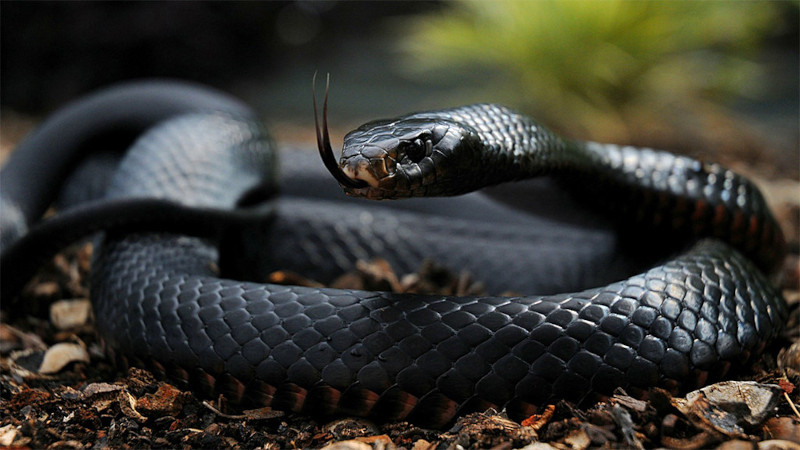Black Mamba Facts
- The descriptive term of Black Mamba serves as the most frequently used common name for this beautiful but deadly reptile. It does have other, less often used names, though. These includes such names as the black-mouthed mamba, and the death kisser.
- Among profesionals, however, such as researchers, the animal’s more often referred to by its technical name. That, though, is a bit of a tongue-twister. That’s because this marvel of evolution bears the cumbersome technical name of Dendroaspis polylepis.
- It received that difficult to pronounce appellation due to the work of the respected German-born British zoologist, Albert Günther. The researcher recorded the first formal acknowledgement of the creature as a separate and distinct species. This he did in 1864.
- Regardless of which term one uses to speak of it, however, it remains a remarkable creation of Nature. It also holds the status of the second-longest of all known poisonous snakes. It’s exceeded in this category only by the phenomenal King Cobra.
- For the moment, the Black Mamba seems to be maintaining a population base that’s both stable and sufficient. This fortunate trend also appears to hold true throughout the entirety of its range. The IUCN, therefore, lists it as Least Concern on its Red List.
- The intriguing snake nevertheless faces some potential threat, at least. In this, its situation mirrors that of mosts species on earth. Habitat degradation or loss poses one potential danger. Its greatest threat, though, most likely comes from climate change.
Related Articles
Black Mamba Physical Description
The extraordinary reptile known as the Black Mamba quickly draws the attention of those who encounter it. The creature does so for several reasons, to be certain. Nonetheless, the sheer physical measurements of this evolutionary marvel usually garner the most attention.
It’s worth noting, however, that unlike a great many reptiles, this species displays virtually no noticeable degree of sexual dimorphism. It’s therefore obviously quite difficult for all but the most experienced researchers to distinguish the sexes of individual specimens.
Overall, mature adults of both genders of this reptile attain an average length ranging from 6 ft 7 in – 9 ft 10 in (2 – 3 m). Exceptional specimens do occur, however. These uncommon individuals sometimes achieve lengths measuring up to as much as 14 ft 9 in (4.5 m).
Not surprisingly, the serpent also develops a long, slender body. It’s also quite cylindrical, even compared to some other snakes. The head of the animal usually develops a form often referred to as coffin-shaped. It also has a pronounced brow ridge, and medium-sized eyes.
As most snakes, the Black Mamba tends to be light in weight, relative to body size. This factor varies, of course, due to lengths of the individual. Of those individuals measured, of varying lengths, an average weight seems to only be approximately 3.5 lb (1.6 kg).
The pure appearance of this powerful creature, though, remains impressive in itself. Despite its name, only a small percentage of adults display a pure black hue. Colors more typically range from yellowish-brown, dark olive green, khaki, and occasionally gunmetal gray.
- Kingdom: Animalia
- Phylum: Chordata
- Class: Reptilia
- Order: Squamata
- Family: Elapidae
- Genus: Dendroaspis
- Species: D. polylepsis
Black Mamba Distribution, Habitat, and Ecology
The remarkable Black Mamba evolved as native to a comparatively broad swathe of the globe. That’s due to the fact that it developed as endemic to a large portion of the continent of Africa. Evidence currently further indicates that the reptile never inhabited a larger range.
More precisely, the large and powerful predator evolved as native to most of the sub-Saharan region of the continent. Its range covers all or most of many countries. This includes, but isn’t limited to, Cameroon, Kenya, Uganda, Tanzania, Zambia, Zimbabwe, and Angola.
Wherever it appears in that range, though, it displays clear preferences in its choice of habitats. That’s because it mainly prefers to make its home in moderately dry regions. This mostly inculdes areas of rocky outcroppings, scrub, light woodland, and semi-dry savanna.
The serpent does, however, also display an impressive adaptibility. Individuals choose to inhabit lowland forests and moist savannas. Populations do appear at altitudes as high as 5,900 ft (1,800 m) above sea level. Most, though, live no higher than 3,300 ft (1,000 m).
Yet another impressive aspect of the Black Mamba lies in its patterns of behavior. It lives its life as both an arboreal and terrestrial species. The snake also displays a strongly diurnal pattern of activity. In both regions, though, it’s capable of moving with surprising speed.
As others of its kind, it has a carnivorous diet. In its case, this consists largely of such prey as birds, bats, hyraxes, and various rodents. Adults, in turn, have few natural predators. Larger birds of prey form the majority of these. Finally, a typical lifespan measures about 11 years.
Species Sharing Its Range
Check out our other articles on 4 Beautiful Butterflies of Asia, Northern Flying Squirrel, Mount Kinabalu, Peacock Butterfly, Moon Orchid, Chinese Giant Salamander, Blue-lipped sea krait

